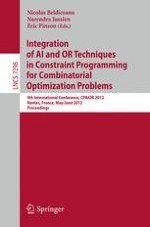2012 | Book
Integration of AI and OR Techniques in Contraint Programming for Combinatorial Optimzation Problems
9th International Conference, CPAIOR 2012, Nantes, France, May 28 – June1, 2012. Proceedings
Editors: Nicolas Beldiceanu, Narendra Jussien, Éric Pinson
Publisher: Springer Berlin Heidelberg
Book Series : Lecture Notes in Computer Science
